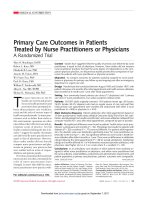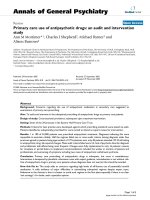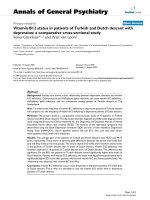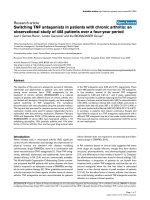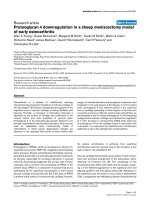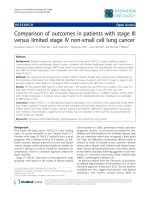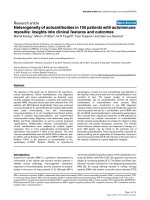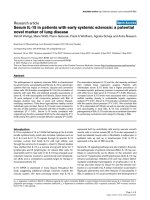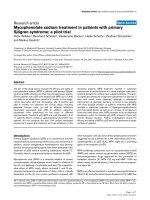Báo cáo y học: "Primary Care Outcomes in Patients Treated by Nurse Practitioners or Physicians" docx
Bạn đang xem bản rút gọn của tài liệu. Xem và tải ngay bản đầy đủ của tài liệu tại đây (254.74 KB, 10 trang )
ORIGINAL CONTRIBUTION
Primary Care Outcomes in Patients
Treated by Nurse Practitioners or Physicians
A Randomized Trial
Mary O. Mundinger, DrPH
Robert L. Kane, MD
Elizabeth R. Lenz, PhD
Annette M. Totten, MPA
Wei-Yann Tsai, PhD
Paul D. Cleary, PhD
William T. Friedewald, MD
Albert L. Siu, MD, MSPH
Michael L. Shelanski, MD, PhD
T
HE MANY PRESSURES ON THE US
health care system and greater
focus on health promotion and
prevention have prompted de-
bates about primary care workforce
needs and the roles of various types of
health care professionals. As nurse prac-
titioners seek to define their niche in
this environment, questions are often
raised about their effectiveness and ap-
propriate scope of practice. Several
studies conducted during the last 2 de-
cades
1-4
suggest the quality of primary
care delivered by nurse practitioners is
equal to that of physicians. However,
these earlier studies did not directly
compare nurse practitioners and phy-
sicians in primary care practices that
were similar both in terms of respon-
sibilities and patient panels.
Over time, payment policies and state
nurse practice acts that constrained the
roles of nurse practitioners have
changed. In more than half the states,
nurse practitioners now practice with-
Author Affiliations: School of Nursing (Drs Mun-
dinger and Lenz and Ms Totten), Joseph L. Mailman
School of Public Health (Dr Tsai), and College of Phy-
sicians and Surgeons (Dr Shelanski), Columbia Univer-
sity, New York, NY; University of Minnesota School of
Public Health, Minneapolis (Dr Kane); Department of
Health Care Policy, Harvard Medical School, Boston,
Mass (Dr Cleary); Metropolitan Life Insurance Com-
pany, New York, NY (Dr Friedewald); and The Mount
Sinai Medical Center, New York, NY (Dr Siu).
Corresponding Author and Reprints: Mary O. Mun-
dinger, DrPH, Columbia University School of Nursing,
630 W 168th St, New York, NY 10032 (e-mail:
).
Context Studies have suggested that the quality of primary care delivered by nurse
practitioners is equal to that of physicians. However, these studies did not measure
nurse practitioner practices that had the same degree of independence as the com-
parison physician practices, nor did previous studies provide direct comparison of out-
comes for patients with nurse practitioner or physician providers.
Objective To compare outcomes for patients randomly assigned to nurse practi-
tioners or physicians for primary care follow-up and ongoing care after an emergency
department or urgent care visit.
Design Randomized trial conducted between August 1995 and October 1997, with
patient interviews at 6 months after initial appointment and health services utilization
data recorded at 6 months and 1 year after initial appointment.
Setting Four community-based primary care clinics (17 physicians) and 1 primary
care clinic (7 nurse practitioners) at an urban academic medical center.
Patients Of 3397 adults originally screened, 1316 patients (mean age, 45.9 years;
76.8% female; 90.3% Hispanic) who had no regular source of care and kept their
initial primary care appointment were enrolled and randomized with either a nurse
practitioner (n = 806) or physician (n = 510).
Main Outcome Measures Patient satisfaction after initial appointment (based on
15-item questionnaire); health status (Medical Outcomes Study Short-Form 36), satis-
faction, and physiologic test results 6 months later; and service utilization (obtained from
computer records) for 1 year after initial appointment, compared by type of provider.
Results No significant differences were found in patients’ health status (nurse prac-
titioners vs physicians) at 6 months (P = .92). Physiologic test results for patients with
diabetes (P = .82) or asthma (P = .77) were not different. For patients with hyperten-
sion, the diastolic value was statistically significantly lower for nurse practitioner pa-
tients (82 vs 85 mm Hg; P = .04). No significant differences were found in health ser-
vices utilization after either 6 months or 1 year. There were no differences in satisfaction
ratings following the initial appointment (P = .88 for overall satisfaction). Satisfaction
ratings at 6 months differed for 1 of 4 dimensions measured (provider attributes), with
physicians rated higher (4.2 vs 4.1 on a scale where 5 = excellent; P = .05).
Conclusions In an ambulatory care situation in which patients were randomly as-
signed to either nurse practitioners or physicians, and where nurse practitioners had
the same authority, responsibilities, productivity and administrative requirements, and
patient population as primary care physicians, patients’ outcomes were comparable.
JAMA. 2000;283:59-68 www.jama.com
For editorial comment see p 106.
©2000 American Medical Association. All rights reserved. JAMA, January 5, 2000—Vol 283, No. 1 59
by guest on September 7, 2011jama.ama-assn.orgDownloaded from
out any requirement for physician su-
pervision or collaboration, and in all
states nurse practitioners have some
level of independent authority to pre-
scribe drugs.
5
Additionally, nurse prac-
titioners are now eligible for direct Med-
icaid reimbursement in every state,
direct reimbursement for Medicare Part
B services as part of the 1997 Balanced
Budget Act,
6
and commercial insur-
ance reimbursement for primary care
services within limits of state law. Fi-
nally, state law determines whether
nurse practitioners are eligible for hos-
pital admitting privileges, either by
regulating access at the state level or by
allowing local hospital boards to de-
cide. The combination of authority to
prescribe drugs, direct reimburse-
ment from most payers, and hospital ad-
mitting privileges creates a situation in
which nurse practitioners and pri-
mary care physicians can have equiva-
lent responsibilities. The present study
is a large randomized trial designed to
compare patient outcomes for nurse
practitioners and physicians function-
ing equally as primary care providers.
The opportunity to compare the 2
types of providers was made possible by
several practice and policy innovations
at the Columbia Presbyterian Center of
New York Presbyterian Hospital in New
York City. In 1993 when the medical
center sought to establish new primary
care satellite clinics in the community,
the nurse practitioner faculty were asked
to staff 1 site independently for adult pri-
mary care. This exclusively nurse prac-
titioner practice was to be similar to the
clinics staffed by physicians. All are
located in the same neighborhood, serve
primarily families from the Dominican
Republic who are eligible for Medicaid,
and follow the policies and procedures
of the medical center. The nurse prac-
titioner practice, theCenter for Advanced
Practice, opened in the fall of 1994.
New York State law allows nurse prac-
titioners to practice with a collabora-
tion agreement that requires the physi-
cian to respond when the nurse
practitioner seeks consultation. Collabo-
ration does not require the collaborat-
ing physician to be on site and requires
only quarterly meetings to review cases
selected by the nurse practitioner and the
physician. The state also grants nurse
practitioners full authority to prescribe
medications, as well as reimbursement
by Medicaid at the same rate as physi-
cians. The medical board granted nurse
practitioners who were faculty mem-
bers in the school of nursing hospital ad-
mitting privileges, thereby making the
basic outpatient services, payment, and
provider responsibilities the same in the
nurse practitioner and physician pri-
mary care practices. Additionally, nurse
practitioners and physicians in the study
were subject to the same hospital policy
on productivity and coverage, and a simi-
lar number of patients were scheduled
per session in each clinic.
While it has been posited that nurse
practitioners have a differentiated prac-
tice pattern focused on prevention with
lengthier visits,
7
this study was pur-
posely designed to compare nurse prac-
titioners and physicians as primary care
providers within a conventional medi-
cal care framework in the same medi-
cal center, where all other elements of
care were identical. Nurse practition-
ers provided all ambulatory primary
care, including 24-hour call, and made
independent decisions for referrals to
specialists and hospitalizations. The
Spanish language ability of the nurse
practitioners and physicians was simi-
lar, although the physicians had some-
what better Spanish facility on aver-
age. All of the nurse practitioners
(n = 7) and most of the physicians
(n = 11) had limited knowledge of
Spanish, and 6 physicians were either
fluent or bilingual. Staff who served as
interpreters were available at each study
site. The central hypothesis was that the
selected outcomes would not differ be-
tween the patients of nurse practition-
ers and physicians.
METHODS
Participants and Randomization
Between August 1995 and October 1997,
adult patients were recruited consecu-
tively at 1 urgent care center and 2 emer-
gency departments that are part of the
medical center. Patients who reported a
previous diagnosis of asthma, diabetes,
and/or hypertension, regardless of the
reason for the urgent visit, were over-
sampled to create a cohort of patients for
whom primary care would have an
impact on patient outcomes, as has been
postulated in previous studies.
8,9
Patients
were screened by bilingual patient
recruiters and asked to participate if they
had no current primary care provider at
the time of recruitment and planned to
be in the area for the next 6 months. The
study was approved by the institutional
review board of Columbia Presbyterian
Medical Center. After an oral explana-
tion of the consent form, written
informed consent was obtained from each
patient (both English and Spanish expla-
nations and forms were available).
Those who provided informed con-
sent were randomly and blindly as-
signed to either the nurse practitioner
or 1 of the physician practices. Differ-
ent assignment ratios were used dur-
ing the recruitment period. Initially the
ratio was 2:1, with more patients as-
signed to the nurse practitioner prac-
tice, because it opened after the physi-
cian practices and was able to accept
more new patients. Subsequently, the
ratio was changed to 1:1 as the nurse
practitioner practice’s patient panel in-
creased. Despite this change, the mean
number of days between the urgent visit
at which patients were recruited and the
follow-up appointments was similar
(8.6 days for patients assigned to nurse
practitioners compared with 8.9 days
for patients assigned to physicians).
Recruited patients were then of-
fered the next available appointments
at the assigned clinic, and project staff
made reminder calls the day before the
appointments. Patients who missed
their appointment were offered an-
other appointment at the assigned prac-
tice. After patients kept their initial ap-
pointments, they were considered
enrolled in the study and eligible for fol-
low-up data collection.
Patients were told which provider
group they were assigned to after ran-
domization, and the type of provider
could not be masked during the course
of care. Patients who refused to partici-
PRIMARY CARE BY NURSE PRACTITIONERS OR PHYSICIANS
60 JAMA, January 5, 2000—Vol 283, No. 1 ©2000 American Medical Association. All rights reserved.
by guest on September 7, 2011jama.ama-assn.orgDownloaded from
pate or were deemed ineligible for the
study were given follow-up primary care
appointments by the study recruiters to
the same practices. Additionally, dur-
ing the study period, all practices re-
ceived new patients from usual sources
such as hospital discharges, recommen-
dations from friends and family, refer-
rals from other physicians, direct ac-
cess by the patients themselves, and
advertising. The study did not require
a different process of care or documen-
tation for enrolled patients.
At the initial visit, the patients be-
came a part of the nurse practitioner or
physician practices’ regular patient
panel, and all subsequent appoint-
ments, care, and treatments were ar-
ranged through the practice site of the
assigned primary care nurse practi-
tioner or physician. The primary care
nurse practitioners and physicians had
the same authority to prescribe, con-
sult, refer, and admit patients. Further-
more, they used the same pool of spe-
cialists, inpatient units, and emergency
departments. No attempt was made to
differentiate study patients from other
patients in the practice or to influence
the practice patterns of the participat-
ing nurse practitioners and physi-
cians. However, patients were free to
change their source of medical care dur-
ing the study. Medicaid in New York
is currently fee-for-service and pa-
tients could go to other providers, go
to a specialist directly, or use the emer-
gency department without notifying
their primary care provider. Approxi-
mately 3% of patients (n = 43) went to
another clinic after keeping the first ran-
domly assigned appointment, and 9%
(n = 116) went to multiple primary care
clinics during the 6-month period.
Data Collection
At the time of recruitment, patients pro-
vided demographic and contact infor-
mation and completed the Medical Out-
comes Study 36-Item Short-Form Health
Survey (SF-36). After the initial pri-
mary care visit, interviewers contacted
the enrolled patients either by tele-
phone or in person, if necessary, to ad-
minister a satisfaction questionnaire. Six
months after this initial appointment, the
enrolled patients were again contacted
and asked to complete a second, longer
interview. The decision to interview pa-
tients 6 months after the initial primary
care visit was based on prior survey ex-
perience with this patient population.
10
The primary care patients served by the
medical center are primarily immi-
grants and frequently change resi-
dences, travel between New York and
their countries of origin, and have inter-
ruptions in telephone service. Attempts
were made to locate all enrolled pa-
tients for this follow-up, including those
who could not be located for the initial
satisfaction interview. At the 6-month in-
terview, the SF-36 and the satisfaction
questionnaire were repeated, and addi-
tional questions were asked about health
services utilization. A research nurse ac-
companied the interviewers, and for pa-
tients who reported a diagnosis of
asthma, diabetes, or hypertension, physi-
ologic data were collected.
Data on all health services utilization
at the assigned practice and all other
medical center sites were obtained from
the medical center computer records for
both the 6 months prior to recruitment
and for 6 months and 1 year after the ini-
tial primary care appointment. These data
were collected for all patients who were
enrolled, including those who could not
be located for the 6-month follow-up in-
terview. Utilization data were also avail-
able for patients who were recruited but
who did not keep their initial primary
care appointment and therefore were not
enrolled in the study. For these pa-
tients, the data were collected for the 6
months prior to recruitment and 6
months and 1 year after the date of the
missed appointment they were given at
recruitment.
Main Outcome Measures
The SF-36 was used as a baseline and fol-
low-up measure of health status. This
instrument elicits patient responses to 36
questions designed to measure 8 health
concepts (general health, physical func-
tion, role-physical, role-emotional, social
function, bodily pain, vitality, and men-
tal health)
11
or to create 2 summary scores
(physical component summaryand men-
tal component summary).
12
The origin
and logic of the item selection, as well
as the psychometrics and tests of clini-
cal validity, have been reported by the
survey’s developers.
13,14
Additionally, the
survey’s utility for monitoring general and
specific populations, measuring treat-
ment benefits, and comparing the bur-
den of different diseases has been docu-
mented in 371studies published between
1988 and 1996.
15,16
For example, the
SF-36 has been used to measure differ-
ences in function between chronically ill
patients with and without comorbid anxi-
ety disorder
17
; has demonstrated that it
can detect changes in health status that
correspond to clinical profiles for 4 com-
mon conditions
18
; and has shown that it
reflects changes in health status that cor-
respond to a predicted clinical course for
elective surgery patients.
19
Patient satisfaction was measured by
using “provider-specific” items from a
15-item satisfaction questionnaire used
in the Medical Outcomes Study.
20
Three
items related to clinic management were
included in the survey to provide the
medical center administration with in-
formation about patients’ perceptions
of the clinic, but those items were not
intended for use in the comparison of
providers.
The survey instruments used in the
study were written in English and then
translated into Spanish. The bilingual
members of the study team reviewed the
Spanish versions to ensure that the
meaning had not been changed. Ap-
proximately 80% (78.8% at recruit-
ment and 83.7% at 6 months) of the in-
terviews were conducted in Spanish.
Physiologic measures included dis-
ease-specific clinical measurements
taken by a research nurse at the time
of the 6-month follow-up interview.
Blood pressure was determined for pa-
tients with hypertension, peak flow for
those with asthma, and glycosylated he-
moglobin for those with diabetes.
Utilization data included hospitaliza-
tions, emergency department visits, ur-
gent care center visits, visits to special-
ists, and primary care visits within the
Columbia Presbyterian Medical Center
PRIMARY CARE BY NURSE PRACTITIONERS OR PHYSICIANS
©2000 American Medical Association. All rights reserved. JAMA, January 5, 2000—Vol 283, No. 1 61
by guest on September 7, 2011jama.ama-assn.orgDownloaded from
system. Only visits with a nurse practi-
tioner or physician at a primary care site
were counted as primary care. Spe-
cialty visits were defined as visits to a
medical specialty clinic or specialist phy-
sician office. Emergency department and
urgent care center visits were com-
bined before analysis.
Sample Size
Recruitment and enrollment goals were
established based on estimates of the
sample size needed to detect a differ-
ence of 5 points on a 100-point scale
for the SF-36 scores on all scales when
comparing 2 groups with repeated mea-
sures. As the randomization ratio was
projected to change during the course
of the study with availability of appoint-
ments, it was projected that the final ra-
tio between the 2 groups would be 1 pa-
tient in the physician group for every
1.5 patients in the nurse practitioner
group. The sample size estimates for un-
equal groups were extrapolated from
those presented by the instrument’s de-
veloper for equal groups, assuming
␣ = .05, 2-tailed t test, and power of
80%. Differences of more than 5 points
are considered clinically and socially
relevant, according to the guidelines for
the interpretation of the survey.
11
Analysis
Baseline demographics and health sta-
tus for the nurse practitioner and phy-
sician groups at randomization and fol-
lowing enrollment were compared using
2
and t tests. Ten of the 12 satisfaction
questions were factor analyzed (the 11th
question that asks whether the patient
would recommend the clinic to family
and friends was left as a separate item;
an item about medication instructions
was dropped, as it was not applicable to
the majority of respondents who were
not prescribed any medications at their
first visit). There were 3 factors with eig-
envalues greater than 1, indicating that
they represented reasonable con-
structs. The first, “provider attributes”
(Cronbach ␣ = .80) rated the provider
on technical skills, personal manner, and
time spent with the patient on a 5-point
scale from poor to excellent. “Overall sat-
isfaction” (Cronbach ␣ = .86) was the
factor created from 2 items addressing
the quality of care received and overall
satisfaction with the visit. The “com-
munications” factor (Cronbach ␣ = .59)
combined 5 areas in which patients may
have had problems understanding the
provider’s assessment and advice. Mean
scores were computed for each factor.
Using the data collected at recruit-
ment, mean baseline scores on the SF-36
for the scales and summary scores were
used to establish the comparability of the
nurse practitioner and physician groups
in terms of health status. Four types of
analyses were conducted using the SF-36
as an outcome measure. The first 2 in-
cluded t tests to compare mean scores for
nurse practitioner and physician pa-
tients at 6-month follow-up (both un-
adjusted and adjusted for baseline de-
mographics and health status) and
baseline to 6-month change scores. The
third was a subgroup analysis designed
to compare the sickest patients. Pa-
tients whose baseline score on the physi-
cal component summary of the SF-36
was in the bottom quartile (sickest) of
the study sample were selected, and
6-month follow-up SF-36 scores were
compared using the same analyses used
for the total sample.
The fourth analysis classified patients
into categories according to the change
from baseline to follow-up in each
patient’s individual scores on the sum-
mary measures. This analysis was mod-
eled on a comparison of patients treated
in health maintenance organization and
fee-for-service systems.
21
The SE of mea-
surement was used to create 3 catego-
ries: “same” (change not greater than
what would be expected by chance), “bet-
ter” (improved more than expected), and
“worse” (declined morethan expected).
12
While these definitionsare based on a sta-
tistical construct, they provide results that
may be more clinically relevant than
mean scores or mean change in scores
over time. A
2
test was then used to com-
pare the distribution of the nurse prac-
titioner and physician patients among
these groups. In addition, the change
from baseline to follow-up for the entire
sample was comparedusing paired t tests.
Ranges and mean values for the
physiologic measures were obtained,
and mean values for the 2 groups were
compared using t tests.
For the analyses of health services uti-
lization, data were obtained for 6 months
prior to the date of recruitment, 6 months
after, and 1 year after the first primary
care visit. Neither the recruitment visit
nor the assigned primary care visit was
included. Comparisons between the
nurse practitioner and physician pa-
tients’ health services utilization after en-
rollment were made using
2
tests (un-
adjusted) and Poisson regression
(adjusted). To compare the utilization
prior to recruitment with that follow-
ing, signed rank tests were used.
The 159 patients (12.1%) who, after
the first visit, either went to a clinic other
than the one assigned or to multiple pri-
mary care clinics were maintained in the
initially assigned group for the analy-
ses, consistent with an intent-to-treat
analysis. All analyses were repeated with-
out these 159 patients, and the results
were the same.
RESULTS
Recruitment, Enrollment,
and Loss to Follow-up
Of the 3397 patients screened and given
follow-up appointments, 41.6% were
not randomized because they either re-
fused to participate (11.2%) or did not
meet the screening criteria (30.4%). Of
the 1981 patients who were random-
ized, 1181 (59.6%) were assigned to the
nurse practitioner clinic and 800
(40.4%) to the physician clinics. The
average age of the randomized pa-
tients was 44.4 years and 74.6% were
female; 84.9% were Hispanic, 8.8% were
black, and 1.1% were white. There were
no statistically significant differences in
the demographics or health status of the
patients randomized to nurse practi-
tioners or physicians (T
ABLE 1).
The 1316 patients (66.4%) who kept
their initial primary care appoint-
ments following randomization were
considered enrolled in the study. This
rate is comparable to the normal rate
of appointments (65%) kept at the par-
ticipating clinics (P. Craig, MA, RN,
PRIMARY CARE BY NURSE PRACTITIONERS OR PHYSICIANS
62 JAMA, January 5, 2000—Vol 283, No. 1 ©2000 American Medical Association. All rights reserved.
by guest on September 7, 2011jama.ama-assn.orgDownloaded from
e-mail message, August 4, 1999). Com-
pared with the 665 patients (32.4%)
who did not keep their appointments,
those who did (the enrolled patients)
differed significantly at baseline in sev-
eral respects. Enrolled patients were
older (45.9 vs 41.3 years); a higher pro-
portion were female (76.8% vs 70.2%)
and Hispanic (90.3% vs 82.9%); a
higher percentage reported a history of
1 or more of the selected chronic con-
ditions (53.7% vs 45.0%); and they had
to wait fewer days for their follow-up
appointments (7.8 vs 10.7). These find-
ings are consistent with other studies
of patient behavior relative to keeping
or missing appointments.
22-24
Our analysis of the data available on
patients who did not keep their pri-
mary care appointments found no dif-
ferences in health services utilization
after 1 year among the patients as-
signed to the nurse practitioner group
and physician group.
The difference in the retention rates
between recruitment and enrollment for
the nurse practitioner group (68.2%) and
the physician group (63.8%) was statis-
tically significant (
2
1
= 4.3, P = .04).
However, neither the patients who
enrolled nor those who failed to keep
their appointments differed signifi-
cantly between the nurse practitioner
and physician groups in terms of base-
line demographics, SF-36 scores, or
patient-reported prior diagnosis of the
selected chronic conditions (Table 1).
Among the nurse practitioner pa-
tients, 59% saw the same provider for
all primary care visits in the first year
after the initial visits compared with
54% of the physician patients, and this
difference was not statistically signifi-
cant (
2
1
= 2.7, P = .11).
Initial satisfaction interviews were
completed for 90.3% (n = 1188) of all
patients who made a first clinic visit
(90.8% of the nurse practitioner group
and 89.4% of the physician group). Al-
most 92% of all completed interviews
took place within 6 weeks of the ini-
tial appointment.
Six-month interviews were com-
pleted for 79% of all enrolled patients
(80.5% of the nurse practitioner group
and 76.7% the physician group). This
completion rate is considered high for
a transient immigrant population and
is comparable to or better than that
achieved by other studies in the area
served by the medical center. The ma-
jority of completed interviews (91.4%)
took place between 180 and 240 days
after the initial appointment. The most
common reasons for loss to follow-up
were the inability to locate the patient
Table 1. Randomized and Enrolled Patient Characteristics at Baseline
*
Randomized Patients Enrolled Patients
Nurse
Practitioner
Group
(n = 1181)
Physician
Group
(n = 800) Comparison
P
Value
Nurse
Practitioner
Group
(n = 806)
Physician
Group
(n = 510) Comparison
P
Value
Mean age, y 44.0 44.9 t = 1.347 .18 45.5 46.7 t = 1.324 .19
Female sex, % 74.2 75.3
2
= 0.291 .59 75.9 78.2 0.932 .33
Race, %
Hispanic 88.2 87.3
91.0 89.3
Black 8.3 10.4 5.5 8.1
White 1.3 0.9
2
= 6.853 .14 1.5 0.8
2
= 5.675 .23
Other 1.8 1.4 1.7 1.8
Unknown 0.4 0.0 0.3 0.0
Mean No. of days between recruitment
and initial appointment
8.6 8.9 t = 0.478 .63 7.9 7.5 t = −0.709 .48
Prevalence of selected chronic conditions,
% of patients reporting each condition
Asthma 20.2 17.6
2
= 2.10 .15 17.9 16.1
2
= 0.702 .40
Diabetes 10.2 11.8
2
= 1.25 .26 11.5 14.3
2
= 2.183 .14
Hypertension 30.0 34.1
2
= 3.79 .05 33.9 38.0
2
= 2.371 .12
MOS SF-36 subscale scores, mean
Physical functioning 63.1 61.5 t = −1.27 .21 61.4 59.2 t = −1.347 .18
Role-physical 40.1 39.0 t = −0.554 .58 38.0 34.5 t = −1.402 .16
Bodily pain 44.5 44.6 t = 0.032 .98 44.0 43.2 t = −0.416 .68
General health 44.5 45.8 t = 1.097 .27 43.7 43.4 t = −0.211 .83
Vitality 48.4 48.3 t = −0.016 .99 47.8 46.7 t = −0.827 .41
Social functioning 60.0 60.0 t = −0.074 .94 59.3 57.8 t = −0.979 .33
Role-emotional 48.5 47.4 t = −0.505 .61 46.9 42.3 t = −1.694 .09
Mental health 55.0 55.7 t = 0.603 .55 54.6 53.7 t = −0.608 .54
Summary scores
Physical component 38.4 38.0 t = −0.637 .52 37.9 37.2 t = −1.041 .30
Mental component 41.3 41.4 t = 0.222 .83 41.1 40.2 t = −1.135 .26
*
MOS SF-36 indicates Medical Outcomes Study Short-Form 36.
PRIMARY CARE BY NURSE PRACTITIONERS OR PHYSICIANS
©2000 American Medical Association. All rights reserved. JAMA, January 5, 2000—Vol 283, No. 1 63
by guest on September 7, 2011jama.ama-assn.orgDownloaded from
(65.9%) or that the patient had moved
out of the area (17%). A small number
of patients (23 [2.8%] in the nurse prac-
titioner group and 16 [3.1%] in the phy-
sician group) refused to complete the
interview when they were contacted.
Five patients (2.9%) were located but
were unable to complete the interview
due to physical limitations or mental ill-
ness, and 3 patients (1.1%) were de-
ceased. The F
IGURE summarizes the
participation rates at each major stage
in the study.
Satisfaction
There were no significant differences in
the scores between nurse practition-
ers and physicians for any of the satis-
faction factors after the first visit
(T
ABLE 2). At the 6-month interview
there were no statistically significant dif-
ferences in “overall satisfaction” or
“communications” factors or in will-
ingness to refer the clinic to others. The
difference in mean score for the “pro-
vider attributes” factor, however, was
significant, with the physician group
rating providers higher than the nurse
practitioner group (4.22 vs 4.12 out of
a possible 5; P = .05). The provider at-
tribute consists of patients’ ratings of
the providers’ technical skill, personal
manner, and time spent with the pa-
tient. The clinical significance of a 0.1
difference on a 5.0 scale is unlikely.
Self-reported Health Status
Overall, the health status of the study
group improved from baseline to fol-
low-up, and the improvement was sta-
tistically significant on every scale
(T
ABLE 3).
There were no significant differ-
ences between the nurse practitioner
and physician patients on any scale or
summary score at 6 months. This is true
for both the unadjusted scores and
scores adjusted for demographics and
baseline health status. The additional
analysis (not shown) of the summary
scores, using the change categories of
“same,” “better,” and “worse” to char-
acterize the clinical course of each pa-
tient, also revealed no significant dif-
ferences between provider types.
Finally, 152 nurse practitioner pa-
tients and 103 physician patients were
defined as the sickest (health status
scores in the bottom quartile of the
sample at baseline) and their scores ana-
lyzed separately. Again, there were no
differences between nurse practi-
tioner and physician patients in scale
scores or summary measures at 6
months (both unadjusted and ad-
justed), nor did the change in scores
from baseline to follow-up differ be-
tween nurse practitioner and physi-
cian patient groups.
Physiologic Measures
The physiologic measures taken at the
time of the interview for patients who
reported 1 of the selected chronic ill-
nesses were not statistically signifi-
cantly different between the nurse prac-
titioner and physician patients for
asthma and hypertension. The mean
peak flow measurements for the 64 phy-
sician patients with asthma was 292
L/min, compared with 297 L/min for the
107 nurse practitioner patients (t
test = −0.29, P = .77). Glycosylated he-
moglobin mean value for the 46 physi-
cian patients with diabetes was 9.4% vs
9.5% for the 58 nurse practitioner pa-
tients (t test = −0.22, P = .82).
Figure. Study Profile
1416 Not Randomized
382 Refused
1034 Did Not Meet Criteria
1181 (59.6%) Randomized to Nurse Practitioner
806 (68.2%) Nurse Practitioner Patients Enrolled 510 (63.8%) Physician Patients Enrolled
375 (31.8%) Missed Appointment 290 (36.3%) Missed Appointment
800 (40.4%) Randomized to Physician
1976 (99.7%) Completed Baseline SF-36
3397 Patients Screened
1981 Patients Randomized
800 (99.3%) Medical Center
Data Available
6 No Record
Found
732 (90.8%) Initial
Satisfaction
Interview
Completed
2 Refused
65 Unable to
Locate
7 Unable to
Complete
649 (80.5%) 6-Month
Interview
Completed
23 Refused
109 Unable to
Locate
23 Left Area
2 Unable to
Complete
509 (99.8%) Medical Center
Data Available
1 No Record
Found
456 (89.4%) Initial
Satisfaction
Interview
Completed
5 Refused
39 Unable to
Locate
10 Unable to
Complete
391 (76.7%) 6-Month
Interview
Completed
16 Refused
73 Unable to
Locate
24 Left Area
6 Unable to
Complete
SF-36 indicates Medical Outcomes Study 36-Item Short-Form Health Survey.
PRIMARY CARE BY NURSE PRACTITIONERS OR PHYSICIANS
64 JAMA, January 5, 2000—Vol 283, No. 1 ©2000 American Medical Association. All rights reserved.
by guest on September 7, 2011jama.ama-assn.orgDownloaded from
For patients with hypertension, there
was no statistically significant differ-
ence in the systolic reading: 139 mm Hg
for the 145 physician patients and 137
mm Hg for the 211 nurse practitioner
patients (t test = 1.08, P = .28). The
mean diastolic reading, however, was
statistically significantly lower
for the nurse practitioner patients at 82
mm Hg compared with 85 mm Hg for
the physician patients (t test = 2.09,
P = .04).
Utilization
For our comparison of outcomes we
analyzed utilization of health care ser-
vices for nurse practitioner and physi-
cian patients who enrolled in the study
by keeping their initial primary care ap-
pointment. There were no statistically
significant differences between the
nurse practitioner and physician pa-
tients for any category of service dur-
ing either the first 6 months or the first
year after the initial primary care visit
for either unadjusted or adjusted use
rates (T
ABLE 4). When the utilization
analyses were repeated for the subsets
of “sickest” patients as defined in the
“Self-reported Health Status” section
Table 2. Patient Satisfaction: Initial Visit and 6-Month Follow-up Interviews
Initial Visit 6-Month Follow-up
Nurse
Practitioner
Group
(n = 726)
Physician
Group
(n = 453) Comparison
P
Value
Nurse
Practitioner
Group
(n = 644)
Physician
Group
(n = 389) Comparison
P
Value
Provider attributes mean score
*
4.16 4.19 t = 0.815 .42 4.12 4.22 t = 1.963 .05
Overall satisfaction mean score
*
4.59 4.60 t = 0.144 .89 4.45 4.46 t = 0.161 .87
Problems, % of patients reporting†
0 74.4 70.2
59.1 62.7
1 15.4 18.7
2
= 2.605 .46
25.1 23.5
2
= 2.146 .54
2 6.5 7.2 10.2 7.8
3-5 3.7 3.9 5.6 5.9
% of patients who would
recommend clinic to others
98.7 98.2
2
= 0.544 .46 95.0 95.1
2
= 0.000 .99
*
Calculated from items rated on a 5-point scale, in which 5 is the most positive response.
†Percentages may not add to 100% due to rounding.
Table 3. Health Status Based on MOS SF-36 Results
*
Comparison of Baseline
and 6-Month Scores for
Entire Sample (n = 1040)
6-Month Scores for Nurse Practitioner Group (n = 649)
and Physician Group (n = 391)
Unadjusted Mean Scores Adjusted Mean Scores†
Baseline 6 mo
Change
(Paired t tests)‡
Nurse
Practitioner
Group
Physician
Group Comparison
Nurse
Practitioner
Group
Physician
Group Comparison§
Physical functioning 60.30 64.26 t = 4.631 64.94 62.90 t = −1.126 64.21 63.78 t = 0.394
P = .26 P = .77
Role-physical 36.06 53.31 t = 10.519 53.74 52.62 t = −0.375 52.92 53.38 t = −0.192
P = .71 P = .85
Bodily pain 42.74 53.01 t = 9.133 53.66 52.07 t = −0.748 52.91 52.73 t = 0.092
P = .45 P = .93
General health 42.94 48.75 t = 7.662 48.79 48.67 t = −0.070 48.42 49.04 t = −0.454
P = .95 P = .65
Vitality 47.02 53.45 t = −7.771 53.86 52.79 t = −0.635 53.27 53.38 t = −0.072
P = .53 P = .94
Social functioning 58.51 70.47 t = 12.507 70.39 70.59 t = 0.114 70.25 70.70 t = −0.279
P = .91 P = .78
Role-emotional 44.70 56.26 t = 7.105 56.71 55.24 t = −0.488 55.81 56.34 t = −0.192
P = .63 P = .85
Mental health 53.51 60.17 t = 8.177 60.75 59.45 t = −0.742 60.37 59.63 t = 0.491
P = .46 P = .62
Physical component summary 37.46 40.63 t = 8.706 40.83 40.29 t = −0.728 40.53 40.60 t = −0.102
P = .47 P = .92
Mental component summary 40.56 44.58 t = 9.438 44.64 44.29 t = −0.398 44.55 44.48 t = 0.103
P = .69 P = .92
*
MOS SF-36 indicates Medical Outcomes Study Short-Form 36.
†Adjusted for age, sex, baseline MOS subscale scores, and each selected chronic condition.
‡P values for change are all Ͻ.001.
§Adjusted t test is based on a regression model, with age, sex, baseline MOS subscale scores, and each condition entered as covariates.
PRIMARY CARE BY NURSE PRACTITIONERS OR PHYSICIANS
©2000 American Medical Association. All rights reserved. JAMA, January 5, 2000—Vol 283, No. 1 65
by guest on September 7, 2011jama.ama-assn.orgDownloaded from
above, no differences were found in the
health care services utilization be-
tween the nurse practitioner and phy-
sician patients (T
ABLE 5). In the 6
months and 1 year after the initial pri-
mary care visit, enrolled patients in both
groups made significantly more pri-
mary care and specialty visits and fewer
emergency/urgent visits than in the 6
months prior to recruitment. The per-
centage of enrolled patients hospital-
ized was not significantly different for
either 6 months or 1 year after the ini-
tial primary care appointment.
COMMENT
This study was designed to compare the
effectiveness of nurse practitioners with
physicians where both were serving as
primary care providers in the same en-
vironment with the same authority. The
hypothesis predicting similar patient
outcomes was strongly supported by the
findings of no significant differences
in self-reported health status, 2 of the
3 disease-specific physiologic mea-
sures, all but 1 of the patient satisfac-
tion factors after 6 months of primary
care, and in health services utilization
at 6 months and 1 year.
The difference between the nurse
practitioner and physician patients’ mean
ratings of satisfaction with provider at-
tributes was small but statistically sig-
nificant. It may be attributable to the fact
that the nurse practitioner practice was
moved to a new site after 2 years and be-
fore recruitment and data collection were
completed; the physician practices were
not moved during the study period.
When the “provider attribute” sub-
scale scores for the nurse practitioner
and physician patients whose 6-month
follow-up period overlapped this move
were compared, the ratings by nurse
practitioner patients were significantly
lower than those of the corresponding
physician patients (4.16 vs 4.36; P = .04).
There was no significant difference in
ratings among patients not affected by
the move. Additional research will be
needed to determine whether this is a
persistent difference or if it results from
conditions unique to this study.
A statistically significant, but small,
difference was discerned in the mean
diastolic blood pressure of patients with
hypertension, with the nurse practi-
tioner group having a slightly lower av-
erage reading at 6 months. Given the
size of this change and the lack of dif-
ferences in self-reported health status,
there does not seem to be an obvious
reason for this difference.
Although insufficientstatistical power
to discerndifferences has beena problem
in muchof theprevious researchcompar-
ing nurse practitionersand physicians,the
sample size inthis study was adequateto
test the hypothesized similarity of nurse
practitioner andphysician groups. Atthe
end ofthe study,power calculations were
repeated using final sample size and the
means andSDs from these data. Thesere-
vealed that the sample size was adequate
to detect differences from baseline to
follow-up between the 2 patient groups
of less than 5 points for 6 of the 8 scales
Table 4. Health Services Utilization
*
Change for Entire Sample, %
6 Months After Initial Primary Care Visit, % 1 Year After Initial Primary Care Visit, %
6 mo Prior
(N = 1309)
6 mo After
(N = 1309)
Change,
z Score†
Nurse
Practitioner
Group
(n = 800)
Physician
Group
(n = 509) Comparison
Nurse
Practitioner
Group
(n = 800)
Physician
Group
(n = 509) Comparison
Primary care visits
0 88.8 21.2
20.6 22.2 18.0 19.1
1 5.7 22.4 22.6 22.0 18.4 16.1
2 2.9 17.3 18.0 16.3
2
= 0.059
P = .81
13.8 13.4
2
= 1.033
P = .31
3 2.6 13.8 −26.809 14.5 12.8 10.3 8.8
4 0 9.8 9.6 10.0 9.3 8.8
5 0 6.1 5.3 7.5 7.5 6.1
Ն6 0 9.3 9.4 9.2 22.9 27.7
Specialty visits
0 89.1 62.3
61.8 63.1 54.5 54.8
1 5.6 14.2
−15.578
13.3 15.7
2
= 0.678
P = .41
13.9 16.5
2
= 0.265
P = .61
2 2.3 9.3 10.8 7.1 8.9 6.3
Ն3 3.1 14.2 14.3 14.1 22.8 22.4
ED and urgent care
0 58.1 76.5
77.4 75.0 65.8 66.2
1 16.4 16.2
−12.937
15.3 17.7
2
= 0.428
P = .51
20.4 17.7
2
= 0.286
P = .59
2 16.4 4.0 4.3 3.7 7.4 8.6
Ն3 9.1 3.3 3.1 3.5 6.5 7.5
Hospitalizations
0 94.5 95.3
−0.884
P=.38
95.9 94.3
2
= 1.703
P = .19
91.5 90.2
2
= 0.664
P = .42
Ն1 5.5 4.7 4.1 5.7 8.5 9.8
*
Percentages may not add to 100% due to rounding. ED indicates emergency department.
†Except for hospitalizations, PϽ.001 for column.
PRIMARY CARE BY NURSE PRACTITIONERS OR PHYSICIANS
66 JAMA, January 5, 2000—Vol 283, No. 1 ©2000 American Medical Association. All rights reserved.
by guest on September 7, 2011jama.ama-assn.orgDownloaded from
(3.2 forgeneral health; 3.3 for vitality;3.4
for mental health; 3.4 for social function;
and 4.2 for bodily pain) and less than 6
points on 2 scales (5.9 on role-physical
and role-emotional). This magnitude of
difference is similar to differences com-
monly reported in studies comparing
groups
21,25
and in studies of change over
time within 1 group.
17,26
There is evidence that the outcome
measures chosen were sensitive enough
to discern any important differences. The
SF-36 is a widely used outcome mea-
sure and its sensitivity has been docu-
mented in several studies.
11,18,27
In this
study, there were sizable and statisti-
cally significant changes for both nurse
practitioner and physician patients in all
scale scores and summary measures from
baseline to follow-up. Some improve-
ment would be expected, even over a
6-month period with or without pri-
mary care, followingthe urgent care visits
at which subject recruitment occurred;
the SF-36 did detect improvement. The
utilization indicators are in widespread
use in cross-sectional and longitudinal
studies. With the exception of number
of hospitalizations, which stayed the
same in both groups, these measures also
changed significantly over time.
Strengths of this study included ad-
equate sample size and the ability to
randomize patients to equivalent clini-
cal settings and to providers with equal
responsibilities. However, there were
also several limitations.
Patients could not be randomized at
the point of initial contact with the pro-
vider. Becausethe nurse practitionerand
physician practice sites were geographi-
cally separate,patients hadto berandom-
ized when they were recruited in the
emergency department or urgent care
center to give them follow-up appoint-
ments at variouslocations with different
appointment schedules.This timeand lo-
cation gap likely contributed to the loss
of almostone thirdof thesample between
randomization and enrollment.Although
this is substantial, it is within the range
reported in similar randomized trials.
28
While the loss rate was significantly
different for the nurse practitioner and
physician groups, there is no reason to
suspect that this represents a system-
atic violation of the protocol or any com-
promise of randomization. Patients
dropped out before receiving care, and
the dropout rate was higher for those
assigned to the traditional model of phy-
sician care. This suggests that assign-
ment to the new model of nurse prac-
titioner care did not negatively influence
patient behavior. There is no evidence
of selection bias in that there were no
significant differences in demograph-
ics, baseline health status, or prerecruit-
ment health services utilization pat-
terns between nurse practitioner and
physician randomized patients, for either
those who enrolled or those who did not
keep their appointments.
Table 5. Subgroup Analyses
*
SF-36 Subscales
Nurse Practitioner
Group
(n = 152)
Physician
Group
(n = 103) Comparison
6-Month MOS SF-36 Scores for the Sickest Patients, Mean (SD)†
Physical functioning 46.69 (27.05) 48.17 (27.46) t = 0.425
P = .67
Role-physical 33.55 (42.88) 32.28 (43.53) t = −0.231
P = .82
Bodily pain 38.10 (29.72) 39.25 (29.36) t = 0.306
P = .76
General health 38.06 (23.02) 37.08 (23.48) t = −0.333
P = .74
Vitality 43.06 (25.21) 42.43 (25.14) t = −0.197
P = .84
Social functioning 62.67 (28.87) 60.56 (29.33) t = −0.568
P = .57
Role-emotional 42.39 (47.25) 43.04 (47.06) t = 0.109
P = .91
Mental health 52.56 (28.11) 50.92 (52.47) t = −4.77
P = .63
Physical component summary 23.71 (3.12) 23.84 (3.58) t = 0.293
P = .77
Mental component summary 39.57 (13.35) 40.39 (12.70) t = 0.490
P = .63
Health Services Utilization for the Subgroup of “Sicker Patients,” No. (%)
(n = 151) (n = 101)
Primary care visits
0 30 (19.9) 17 (16.8)
1 31 (20.5) 21 (20.8)
2
= 0.144
2 27 (17.9) 21 (20.8) P = .71
Ն3 63 (41.7) 42 (41.6)
Specialty visits
0 82 (54.3) 56 (55.4)
1 23 (15.2) 21 (20.8)
2
= 0.390
2 20 (13.2) 8 (7.9) P = .53
Ն3 26 (17.2) 16 (15.8)
ED and urgent care center visits
0 108 (71.5) 79 (78.2)
1 28 (18.5) 17 (16.8)
2
= 1.81
2 9 (6.0) 2 (2.0) P = .18
Ն3 6 (4.0) 3 (3.0)
Hospitalizations
0 142 (94.0) 99 (96.1)
1 7 (4.6) 3 (2.9)
2
= 0.542
2 1 (0.7) 1 (1.0) P = .46
3 1 (0.7) 0 (0)
*
Percentages may not add to 100% due to rounding. MOS SF-36 indicates Medical Outcomes Study Short-Form 36;
ED, emergency department.
†Selection of “sickest patients” was determined using MOS SF-36 scores using the bottom quartile of the baseline
physical component summary. Patients with a score below 28.16 were included.
PRIMARY CARE BY NURSE PRACTITIONERS OR PHYSICIANS
©2000 American Medical Association. All rights reserved. JAMA, January 5, 2000—Vol 283, No. 1 67
by guest on September 7, 2011jama.ama-assn.orgDownloaded from
A 1-year follow-up for SF-36 and pa-
tient satisfaction would have been more
useful than taking these measures at 6
months. In part, we believed a popula-
tion with limited access to health care
would show changes in these measures
in 6 months. But more influential in the
decision regarding follow-up was the
knowledge that this population is diffi-
cult to track because of changing ad-
dresses, changing eligibility for Medic-
aid, and frequent extended trips out of
the country. Although we do have ser-
vice utilization data for both 6 months
and 1 year, data on satisfaction and self-
perceived health status were not col-
lected for 1 year.
Finally, the study had some charac-
teristics that limit the generalizability of
results. It was conducted in medical cen-
ter–affiliated, community-based pri-
mary care clinics, which may differ from
individual providers or small group prac-
tices. The providers were faculty from
a university medical center, hence were
not necessarily typical of those in non-
academic practice settings. The pa-
tients were predominantly immigrants
from the Dominican Republic who were
eligible for Medicaid and many did not
speak English. This differs from the set-
ting in which many commercially in-
sured patients receive primary care but
does resemble other academic, public
and safety net providers, and the Med-
icaid populations they serve. While the
setting and patient population are limi-
tations, they are also what permitted ran-
domized assignment and an environ-
ment in which nurse practitioners and
physicians were able to function equally
as primary care providers. The ability to
do this type of study, even in a setting
atypical for some patients, adds signifi-
cant weight to the results from prior
studies that have demonstrated the com-
petence of nurse practitioners.
Who provides primary care is an im-
portant policy question. As nurse prac-
titioners gain in authority nationally with
commercially insured and Medicare
populations now accessing nurse prac-
titioner care, additional research should
include these populations. As cost and
quality issues pervade the public de-
bate on managed care, those who are the
first-line health care providers become
pivotal resources in the emerging health
care system. Nurse practitioners have
been evaluated as primary care provid-
ers for more than 25 years, but until now
no evaluations studied nurse practition-
ers and physicians in comparable prac-
tices using a large-scale, randomized de-
sign. The results of this study strongly
support the hypothesis that, using the
traditional medical model of primary
care, patient outcomes for nurse practi-
tioner and physician delivery of pri-
mary care do not differ.
Funding/Support: Grant support for this study was
received from the Division of Nursing, Health Re-
sources and Services Administration, US Department
of Health and Human Services; The Fan Fox and Les-
lie R. Samuels Foundation; and the New York State
Department of Health.
Acknowledgment: This study would not have been pos-
sible without the cooperation of the management, site
administrators, patient representatives, and providers
(nurse practitioners and physicians) of the Ambula-
tory Care Network Corporation at New York Presby-
terian Hospital. Members of the faculty at the School
of Nursing participated in the early development of both
the Nurse Practitioner Practice and the Evaluation Study.
These include Richard Garfield, DrPH; Theresa Dod-
dato, EdD; Patrick Coonan, EdD; Mary Jane Koren, MD;
and Julie Sochalski, PhD. We also gratefully acknowl-
edge the contributions of the staff of the Evaluation of
Primary Care in Washington Heights project: data man-
agers Susan Fairchild, MPH, and Susan Xiaoqin Lin,
MPH; project coordinator Monte Wagner, BSN; assis-
tant coordinators Hussein Saddique, BA, and Selene
Wun, BS; patient recruiters and interviewers Delmy Mi-
randa, BA, Niurka Suero, Hendricks Vanderbilt, Eddy
Spies, Ana Sanchez, Tamara Ooms, BSN, Eileen Co-
loma, BSN, Maricruz Polanco, BA, Hector Caraballo, BS,
and Carlos Tejada; research nurses Michele Megre-
gian, MS, Carina Ryder, MS, Jennifer Cotto, MS, Mi-
lan Gupta, MS, Patricia McGovern, MS, Joshua Ven-
dig, MS, FNP, and especially Kate Hogarty, MS.
REFERENCES
1. Spitzer WO, Sackett DL, Sibley JC, et al. The Bur-
lington randomized trial of the nurse practitioner.
N Engl J Med. 1974;290:251-256.
2. Brown SA, Grimes DE. A meta-analysis of nurse
practitioners and nurse midwives in primary care. Nurs
Res. 1995;44:332-339.
3. US Congress, Office of Technology Assessment.
Nurse Practitioners, Physician Assistants, and Certi-
fied Nurse-Midwives: A Policy Analysis. Washing-
ton, DC: US Government Printing Office; 1986. Health
Technology Case Study 37.
4. Safriet BJ. Health care dollars and regulatory sense.
Yale J Regul. 1992;9:417-488.
5. Pearson LJ. Annual update of how each state stands
on legislative issues affecting advanced nursing prac-
tice. Nurse Pract. 1999;24:16-19, 23-24, 27-30.
6. The Balanced Budget Act of 1997, Pub L No. 105-33.
7. Mundinger MO. Advanced-practice nursing—
good medicine for physicians? N Engl J Med. 1994;
330:211-214.
8. Bindman AB, Grumbach K, Osmond D, et al. Pre-
ventable hospitalizations and access to health care.
JAMA. 1995;274:305-311.
9. Billings J, Anderson GM, Newman LS. Recent find-
ings on preventable hospitalizations. Health Aff (Mill-
wood). 1996;15:239-249.
10. Garfield R, Broe D, Albano B. The role of aca-
demic medical centers in delivery of primary care 1995.
Acad Med. 1995;70:405-409.
11. Ware JE Jr, Snow K, Kosinski M, Gandek B. SF-36
Health Survey: Manual & Interpretation Guide.
Boston, Mass: New England Medical Center; 1993.
12. Ware JE Jr, Snow K, Kosinski M, Gandek B. SF-36
Physical and Mental Health Summary Scales: A Us-
er’s Manual. Boston, Mass: The Health Institute, New
England Medical Center; 1994.
13. Ware JE Jr, Sherbourne CD. The MOS 36-Item Short-
Form Health Survey (SF-36), I: conceptual framework
and item selection. Med Care. 1992;30:473-483.
14. McHorney CA, Ware JE Jr, Raczek AE. The MOS
36-Item Short-Form Health Survey (SF-36), II: psy-
chometric and clinical tests of validity in measuring
physical and mental health constructs. Med Care. 1993;
31:247-263.
15. Shiely JC, Bayliss M, Keller S, Tsai C, Ware JE Jr.
SF-36 Health Survey Annotated Bibliography: First Edi-
tion (1988-1995). Boston, Mass: The Health Insti-
tute, New England Medical Center; 1996.
16. Tsai C, Bayliss M, Ware JE Jr. SF-36 Survey An-
notated Bibliography: 1996 Supplement. Boston, Mass:
New England Medical Center; 1997.
17. Sherbourne CD, Wells KB, Meredith LS, Jackson
CA, Camp P. Comorbid anxiety disorder and the func-
tioning and well-being of chronically ill patients of gen-
eral medical providers. Arch Gen Psychiatry. 1996;
53:889-895.
18. Garratt AM, Ruta DA, Abdalla MI, Russell IT. SF-36
health survey questionnaire, II: responsiveness to
changes in health status in four common clinical con-
ditions. Qual Health Care. 1994;3:186-192.
19. Mangione CM, Goldman L, Orav EJ, et al. Health-
related quality of life after elective surgery. J Gen
Intern Med. 1997;12:686-697.
20. Rubin HR, Gandek B, Rogers WH, Kosinski M,
McHorney CA, Ware JE Jr. Patients’ ratings of outpa-
tient visits in different practice settings: results from the
Medical Outcomes Study. JAMA. 1993;270:835-840.
21. Ware JE Jr, Bayliss MS, Rogers WH, Kosinski M, Tar-
lov AR. Differences in 4-year health outcomes for elderly
and poor, chronically ill patients treated in HMO and
fee-for-service systems. JAMA. 1996;276:1039-1047.
22. Deyo RA, Inui TS. Dropouts and broken appoint-
ments: a literature review and agenda for future re-
search. Med Care. 1980;18:1146-1157.
23. Vikander T, Parnicky K, Demers R, Frisof K, Dem-
ers P, Chase N. New-patient no-shows in an urban fam-
ily practice center. J Fam Pract. 1986;22:263-268.
24. Dockerty JD. Outpatient clinic nonarrivals and can-
cellations. N Z Med J. 1992;105:147-149.
25. Kusek JW, Lee JY, Smith DE, et al. Effect of blood
pressure control and antihypertensive drug regimen
on quality of life. Control Clin Trials. 1996;17(suppl
4):40S-46S.
26. Temple PC, Travis B, Sachs L, Strasser S, Choban
P, Flancbaum L. Functioning and well-being of pa-
tients before and after elective surgical procedures.
J Am Coll Surg. 1995;181:17-25.
27. Kopjar B. The SF-36 health survey: a valid mea-
sure of changes in health status after injury. Inj Prev.
1996;2:135-139.
28. Bertakis KD, Callahan EJ, Helms LJ, Azari R, Rob-
bins JA, Miller J. Physician practice styles and patient out-
comes. Med Care. 1998;36:879-891.
PRIMARY CARE BY NURSE PRACTITIONERS OR PHYSICIANS
68 JAMA, January 5, 2000—Vol 283, No. 1 ©2000 American Medical Association. All rights reserved.
by guest on September 7, 2011jama.ama-assn.orgDownloaded from
